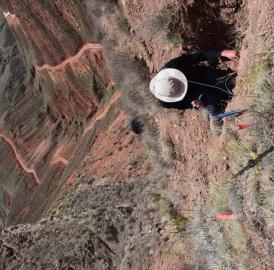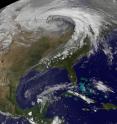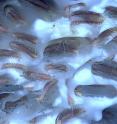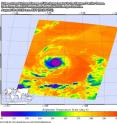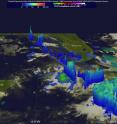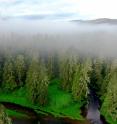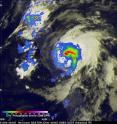Popular Science articles about Earth & Climate
Land-based food not nutritionally sufficient for wild polar bears, according to new study
A study, by San Diego Zoo Global conservationists, released this week (Sept. 12, 2016) is shedding new light on how scientists evaluate polar bear diet and weight loss during their fasting season. On average, a polar bear loses up to...
NASA sees Super Typhoon Meranti's extreme rainfall
 Satellite data from NASA revealed that powerful storms in Super
Typhoon Meranti were generating almost a foot or almost 300
millimeters of rainfall per hour. The Global Precipitation
Measurement mission...
Satellite data from NASA revealed that powerful storms in Super
Typhoon Meranti were generating almost a foot or almost 300
millimeters of rainfall per hour. The Global Precipitation
Measurement mission...
Chemistry says Moon is proto-Earth's mantle, relocated
 Measurements of an element in Earth and Moon rocks have just disproved the leading hypotheses for the origin of the Moon.
Measurements of an element in Earth and Moon rocks have just disproved the leading hypotheses for the origin of the Moon.
NIST and Navy tests suggest telecom networks could back up GPS time signals
 Precision time signals sent through the Global Positioning System (GPS) synchronize cellphone calls, time-stamp financial transactions, and support safe travel by aircraft, ship, train and car.
Precision time signals sent through the Global Positioning System (GPS) synchronize cellphone calls, time-stamp financial transactions, and support safe travel by aircraft, ship, train and car.
Forecasting climate change's effects on biodiversity hindered by lack of data
An international group of biologists is calling for data collection on a global scale to improve forecasts of how climate change affects animals and plants.
NASA sees remnants of Tropical Cyclone Newton over Southwestern US
 NASA's Aqua satellite passed over the U.S. Southwest and captured infrared data on the clouds associated with former Tropical Cyclone Newton.
NASA's Aqua satellite passed over the U.S. Southwest and captured infrared data on the clouds associated with former Tropical Cyclone Newton.
Study finds increased ocean acidification due to human activities
Oceanographers from MIT and Woods Hole Oceanographic Institution report that the northeast Pacific Ocean has absorbed an increasing amount of anthropogenic carbon dioxide over the last decade, at a rate...
NASA sees Hurricane Newton approaching landfall in Baja California, Mexico
 NASA's Terra satellite and a NASA animation of imagery from NOAA's GOES-West satellite provided views of Hurricane Newton as it neared landfall in Baja California, Mexico, today, Sept. 6.
NASA's Terra satellite and a NASA animation of imagery from NOAA's GOES-West satellite provided views of Hurricane Newton as it neared landfall in Baja California, Mexico, today, Sept. 6.
IUCN-led panel finds critically endangered whales in Russia recovering
International Union for Conservation for Nature, WWF and International Fund for Animal Welfare (IFAW) examines the results of the work of an IUCN-led independent panel of scientists, which has been...
Study: Earth's carbon points to planetary smashup
 Research by Rice University Earth scientists suggests that
virtually all of Earth's life-giving carbon could have come from a
collision about 4.4 billion years ago between Earth and an embryonic...
Research by Rice University Earth scientists suggests that
virtually all of Earth's life-giving carbon could have come from a
collision about 4.4 billion years ago between Earth and an embryonic...
NASA takes parting look at Hermine
 Tropical Cyclone Hermine was just a swirl of clouds with no
rainfall off the coast of southeastern Massachusetts on Thursday,
Sept. 8. Just two days earlier, the GPM satellite saw...
Tropical Cyclone Hermine was just a swirl of clouds with no
rainfall off the coast of southeastern Massachusetts on Thursday,
Sept. 8. Just two days earlier, the GPM satellite saw...
NASA sees formation of Central Atlantic Tropical Storm Ian
The low pressure area known as System 94L developed into Tropical Storm Ian on Sept. 14. NOAA's GOES-East satellite data was made into an animation that showed the...
One-tenth of the world's wilderness lost in 2 decades
A research team including Professor William Laurance from James Cook University has discovered there has been a catastrophic decline in global wilderness areas during the past 20 years.
Study finds earthquakes can trigger near-instantaneous aftershocks on different faults
 According to a new study by scientists at Scripps Institution of
Oceanography at the University of California San Diego, a large
earthquake on one fault can trigger large aftershocks on...
According to a new study by scientists at Scripps Institution of
Oceanography at the University of California San Diego, a large
earthquake on one fault can trigger large aftershocks on...
Seeing the forest for the trees: World's largest reforestation program overlooks wildlife
 After years of environmental destruction, China has spent billions
of dollars on the world's largest reforestation program, converting
a combined area nearly the size of New York and Pennsylvania back...
After years of environmental destruction, China has spent billions
of dollars on the world's largest reforestation program, converting
a combined area nearly the size of New York and Pennsylvania back...
Future fisheries can expect $10 billion revenue loss due to climate change
Global fisheries stand to lose approximately $10 billion of their annual revenue by 2050 if climate change continues unchecked, and countries that are most dependent on fisheries for food will...
OU study demonstrates seasonality of bird migration in response to environmental cues
 A University of Oklahoma study demonstrates for the first time that
remote sensing data from weather surveillance radar and
on-the-ground data from the eBird citizen science database both
yield robust...
A University of Oklahoma study demonstrates for the first time that
remote sensing data from weather surveillance radar and
on-the-ground data from the eBird citizen science database both
yield robust...
Nutrient pollution is changing sounds in the sea
Nutrient pollution emptying into seas from cities, towns and agricultural land is changing the sounds made by marine life - and potentially upsetting navigational cues for fish and other sea...
During drought, dry air can stress plants more than dry soil
 Newly published research by Indiana University scientists finds
that low relative humidity in the atmosphere is a significant,
growing and often under-appreciated cause of plant stress in hot,
dry weather...
Newly published research by Indiana University scientists finds
that low relative humidity in the atmosphere is a significant,
growing and often under-appreciated cause of plant stress in hot,
dry weather...
NASA sees Namtheun dissipating in the Sea of Japan
 NASA's Aqua satellite passed over the Sea of Japan and saw Tropical Depression Namtheun weakening.
NASA's Aqua satellite passed over the Sea of Japan and saw Tropical Depression Namtheun weakening.
A strange thing happened in the stratosphere
 This disruption to the wind pattern - called the "quasi-biennial
oscillation" - did not have any immediate impact on weather or
climate as we experience it on Earth's surface. But...
This disruption to the wind pattern - called the "quasi-biennial
oscillation" - did not have any immediate impact on weather or
climate as we experience it on Earth's surface. But...
More news about Earth & Climate
Climate News in Images
Breaking science news from the newsfeed about Earth & Climate
- US study: Climate change goosed odds of freaky warm February
- Malta's iconic Azure Window rock arch collapses into the sea
- Carbon Dioxide Could Reach 410 PPM This Month
- Reusable sponge soaks up oil, could revolutionize spill cleanup
- 'Bugs Bunny,' 'Scooby-Doo' will be available to stream via new Boomerang platform
- Carolina Panthers DE Charles Johnson re-signs, recruits Julius Peppers
- Florida homeowners say cruise ship came within 100 feet of porch
- Dirk Nowitzki hits 30,000 points, leads Dallas Mavericks past Los Angeles Lakers
- Fault System Off San Diego, Orange, Los Angeles Counties Could Produce Magnitude 7.3 Quake
- Massive rogue waves aren’t as rare as previously thought
- Flashy first images arrive from NOAA's GOES-16 lightning mapper
- An Aquaponic Vertical Farm Grows in Brooklyn
- Cultivating a City
- US desert songbirds at risk in a warming climate
- Indianapolis installs tiny ramps to save ducklings from drowning
- Bright pink tap water baffles Canadian town
- Avalanche strikes busy ski resort in the French Alps
- China: U.S., North Korea on collision course
- ‘Black swan’ events strike animal populations
- Oklahoma oil, gas tax collections lower year-over-year
- Overhaul planned for refinery in Kirkuk, Iraq
- Follow #Sentinel2Go
- Lost and Found: Antarctic Balloon Telescope in Good Shape After a Year on the Ice
- EPA scraps methane reporting for oil and gas industries
- Advocates turn focus to Minnesota oil pipeline
- Scarlett Johansson files for divorce from Romain Dauriac
- Sinking of California's San Joaquin Valley Seen from Space
- When it rains, Los Angeles sends billions of gallons of 'free liquid gold' down the drain
- NBA roundup: recap, scores, notes for every game played on March 6
- Australia, Malaysia hope MH370 will be found one day
